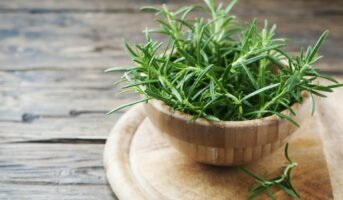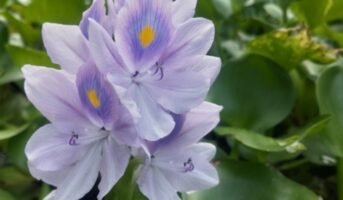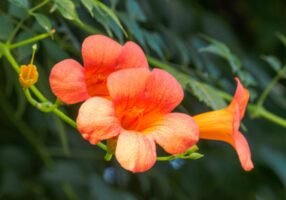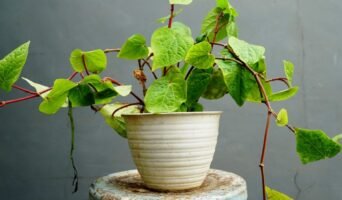Jacaranda mimosifolia is a tropical tree that grows to a height of 25-30 feet and has glossy green leaves. Although it is indigenous to Central America, it grows all over the world in warm areas. It is often used in landscapes and can be a great addition to the back of your yard or garden.
The leaves are large and heart-shaped, with pale green veins running along the edges. The flowers appear in the late spring and summer months on tall, arching racemes that extend from the branches of the tree.
Jacaranda mimosifolia: Quick facts
| Botanical Name | Jacaranda mimosifolia |
| Common Name | Blue Jacaranda |
| Genus | Jacaranda |
| Family | Bignoniaceae |
| Mature Size | 25–50 ft. tall |
| Cultivation | South America, Europe, North America |
| Benefits | Hot baths with Jacaranda leaves help to heal wounds and skin infections. |
Jacaranda mimosifolia physical description

Source: Pinterest
The Jacaranda mimosifolia shrub grows to a height of up to six feet. The leaves of the Jacaranda mimosifolia are bright red and can grow up to four inches long. The flowers of the Jacaranda mimosifolia are purple, and in the shape of a panicle. The Jacaranda mimosifolia is also found in South America, from Panama to Bolivia.
Types of Jacaranda Tree
Some notable varieties of Jacaranda mimosifolia are:
- J. mimosifolia ‘Alba’ or ‘White Christmas’, which is a full-size tree. It has a similar habit and care needs and reaches up to a height of 40 feet and 60 feet in width. It has lush foliage and white flowers that bloom earlier than other varieties.
- J. mimosifolia ‘Bonsai Blue’ is a dwarf variety characterised by deep purple blooms. The mature height of the plant is only 10 to 12 feet and width of six to eight feet.
- Jacaranda jasminoides is another dwarf cultivar of the Jacaranda mimosifolia tree, with a maximum height of 10 to 25 feet. The flowers are lilac to dark purple tubular.
- Jacaranda jasminoides ‘Maroon’ is also a dwarf variety of Jacaranda mimosifolia. The tree attains a maximum height of 10 to 25 feet and produces dark maroon-purple flowers.
How to grow Jacaranda mimosifolia?

Source: Pinterest
Start by planting Jacaranda mimosifolia seeds outdoors in spring or fall. You can also replant your Jacaranda mimosifolia plants from last year’s seeds. If you don’t have time for such a labour-intensive process, you can buy them from a nursery instead.
After you have planted your seedlings, water them regularly until they’re well established. They will need more water than usual during their blooming season, so keep an eye on how much they need throughout their growth cycle.
Once your Jacaranda mimosifolia plants are in full bloom, cut back on the amount of water they receive until the next season begins again. This ensures that they’ll keep producing flowers without becoming overly stressed out during periods when little sunshine or rain falls around them.
Jacaranda mimosifolia prefers full sunlight, but it will grow well in partial shade as long as it gets enough water during its growing season. It requires moderate watering during dry seasons, but it can survive without water for one year if there is no rain or snowfall during this period.
How hard is Jacaranda Mimosifolia to grow?
Jacaranda mimosifolia grow well in ideal conditions, especially in regions such as Hawaii, the South, Southern California, and certain regions of Texas in the United States. Under optimum availability of water, sunlight and temperature, the plant grows quickly. However, when these requirements are not met, problems arise more frequently. Lack of sufficient water can lead to in adequate production of chlorophyll in the plants. It could result in chlorosis, where the green leaves of the plant begin to turn yellow. Hence, regular watering is necessary, especially deep watering is a must in hot temperatures. Infected Jacaranda mimosifolia trees with the bacterial insect-borne leaf scorch disease may be lacking in water.
What is another name for a Jacaranda Mimosifolia?
Jacaranda Mimosifolia is also known by different names such as blue jacaranda, black poui, Nupur or fern tree. It belongs to the Jacaranda genus from the Bignoniaceae family.
Jacaranda mimosifolia: Maintenance tips
Jacaranda Mimosifolia is an evergreen tree that can grow up to 30 feet tall. The flowers are purple, fragrant, and star-shaped.
Sunlight
This plant is best grown in full or partial sunlight. However, it will tolerate some shade provided the soil is well drained.
Soil
It prefers moist soil but does not require it to stay wet all year round. It also prefers neutral to acidic soil pH levels.
Water
Water the tree when you notice the top three to four inches of soil is dry to the touch. The trees require consistent moisture throughout the year and additional watering during high heat.
Pruning
The plant requires little maintenance besides regular pruning, which helps maintain its shape and health. Once a year, in the summer, pruning should be done to eliminate dead branches and encourage the development of new buds.
Fertiliser
Apply a balanced tree fertiliser to the jacaranda tree once a year. Avoid over-fertilising with nitrogen, which can reduce flowering.
Temperature
Some jacaranda trees can survive occasional cold up to 20 degrees Fahrenheit or -6 degrees Celsius by may not grow in regions with excess freezing temperatures. The plant prefers heat and humidity. However, it can suffer from trunk scald in areas where the temperature is always high.
Pests
Pests can be controlled by dousing the plant with neem oil or insecticidal soap as necessary.
Jacaranda mimosifolia uses and benefits

Source: Pinterest
The Jacaranda mimosifolia is widely used throughout Central America as a decorative plant, along highways and other public areas. It can also be used for ornamental purposes indoors or outdoors, where it will bloom throughout the year.
In the traditional medicine of many peoples, almost all parts of the Jacaranda mimosifolia are used ethnobotanically. The flowers, leaves, and bark of the plant cure neuralgia, varicose veins, and other infections.
A valuable ornamental plant, Jacaranda mimosifolia has light foliage very similar to ferns. It also has an interesting form and rich, abundant flowering that lasts for 50 to 60 days under ideal conditions.
Is Jacaranda mimosifolia toxic?
Jacaranda mimosifolia is not at all toxic to pets or humans.
Jacaranda mimosifolia: Common pests
The Jacaranda tree is prone to several common pests such as aphids, scale insects, and mealybugs that feed on the tree leaves and stems, harming and stressing the plant. Moreover, borers and caterpillars may eat holes into a tree’s trunk and limbs, which can weaken the tree and make it vulnerable to storms. If not controlled, the common pests can damage a Jacaranda tree.
However, you can adopt some simple method to keep these pests away. For example, apply neem oil or insecticidal soap treatments regularly to keep the tree healthy and pest-free. Further, keep pets away from newly planted Jacaranda trees.
FAQs
What is the most popular place to find Jacaranda trees?
Jacaranda trees are strictly southern trees that thrive in Florida, Texas, and California.
What is the growing time for a Jacaranda mimosifolia plant?
During its first few years of life, it grows about ten feet a year in a tropical environment.
What does the Jacaranda symbolise?
The tree symbolises wisdom, rebirth, wealth, and good fortune.
What is the water requirement for Jacaranda trees?
It is recommended to water Jacaranda once every two weeks during the spring and summer months.
Housing News Desk is the news desk of leading online real estate portal, Housing.com. Housing News Desk focuses on a variety of topics such as real estate laws, taxes, current news, property trends, home loans, rentals, décor, green homes, home improvement, etc. The main objective of the news desk, is to cover the real estate sector from the perspective of providing information that is useful to the end-user.
Facebook: https://www.facebook.com/housing.com/
Twitter: https://twitter.com/Housing
Email: [email protected]











